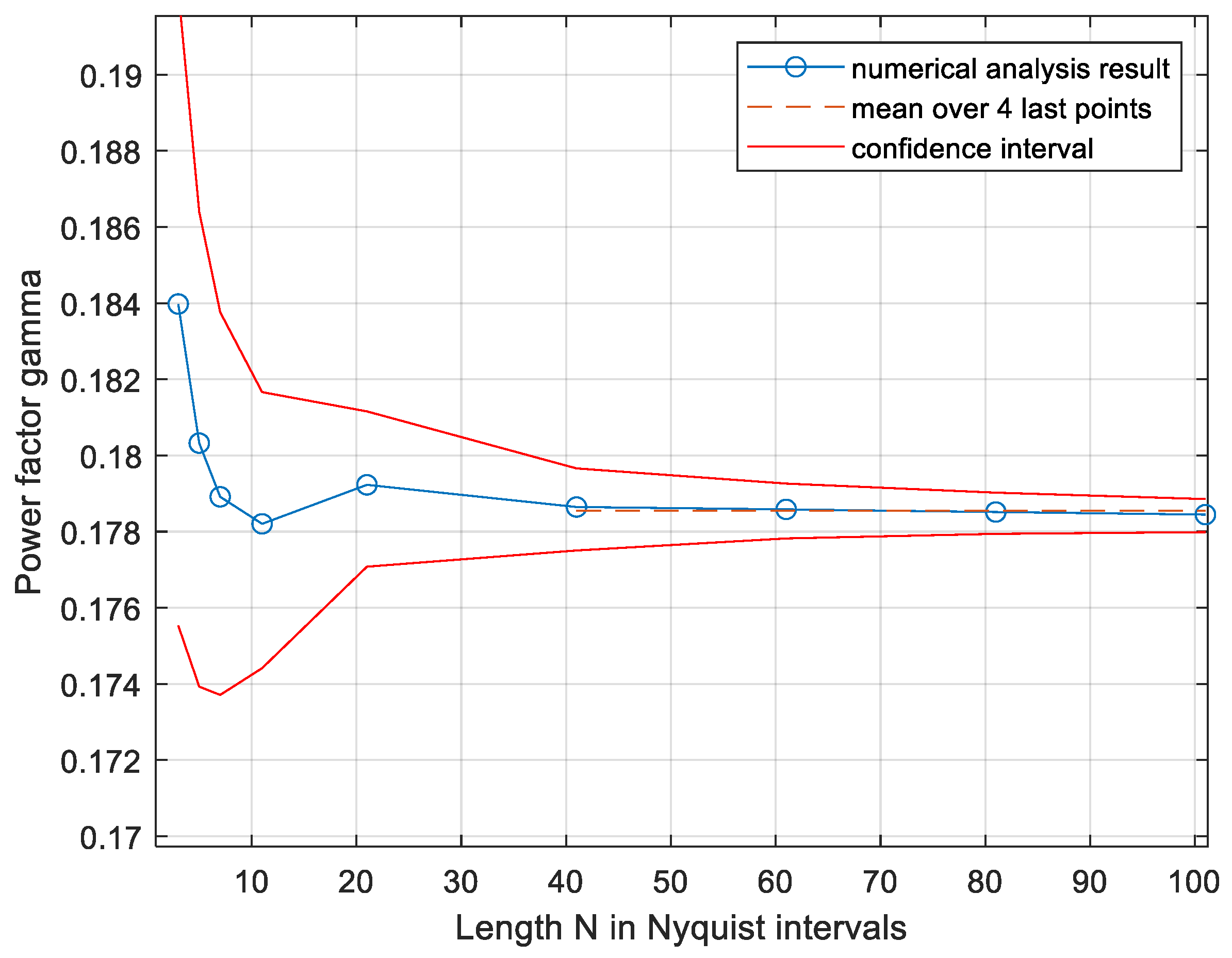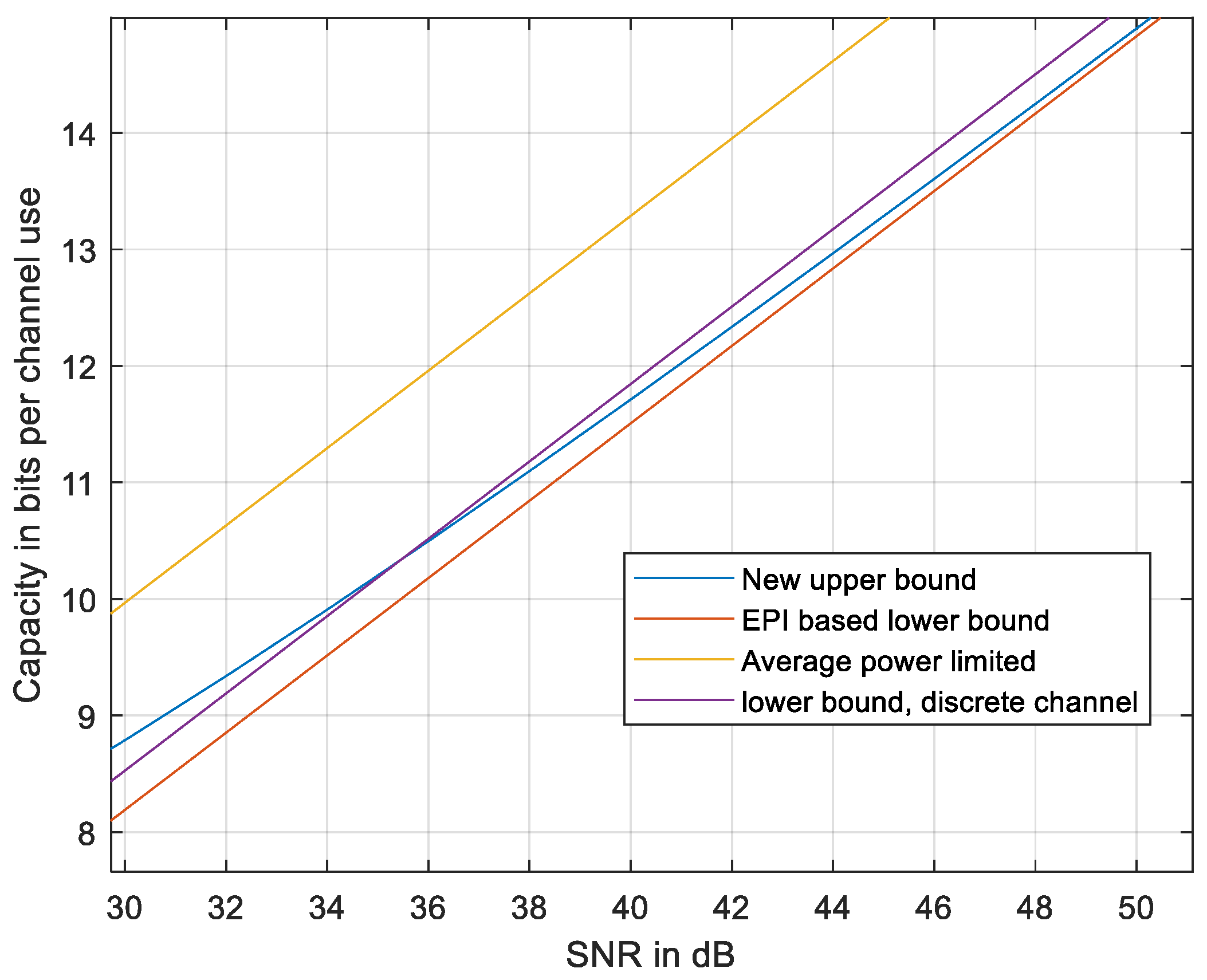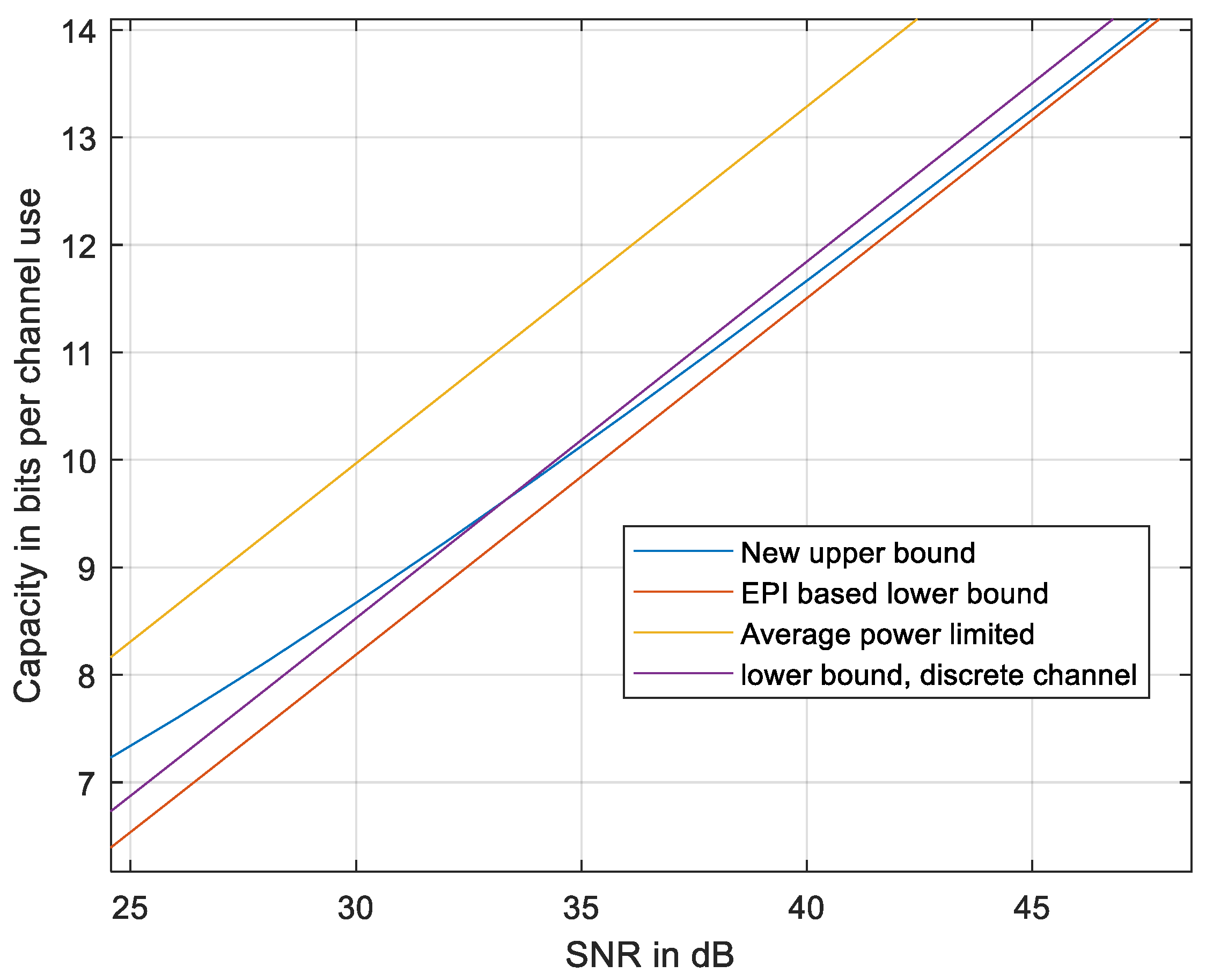Geometry-Based Bounds on the Capacity of Peak-Limited and Band-Limited Signals over the Additive White Gaussian Noise Channel at a High SNR
Abstract
1. Introduction
2. System Model
3. Bounds on Capacity
3.1. On the Shape of the Signal Set
3.2. Volume-Based Lower Bound

3.3. Geometry-Based Upper Bound
3.3.1. Analysis
- The base of each section is a small area on the N-1 -dimensional surface of around some point denoted z. or a small M-1—dimensional body, M < N, around z in the surface of or the point zitself.
- The section extends from the base outward along a line G perpendicular to the supporting hyperplane at z. The section is narrow enough to render py(y) a function py(g) of g only where g is the distance of y in the section from the supporting hyperplane. There may be several supporting hyperplanes at any z, e.g., at the special vertexes presented in Section 3.1 above.
- The intersection between the section and a hyperplane parallel to the supporting hyperplane and at a distance g from it has an (N-1) volume S(g). The volume S(g) is a non-decreasing function of g.
3.3.2. Numerical Analysis of the Upper Bound
4. Band-Pass Signals
4.1. Signal Representation
4.2. Lower Bound
4.3. Upper Bound
5. Conclusions
Author Contributions
Funding
Institutional Review Board Statement
Data Availability Statement
Acknowledgments
Conflicts of Interest
Appendix A. Reshaping the Sections
References
- Haider, M.F.; You, F.; He, S.; Rahkonen, T.; Aikio, J.P. Predistortion-Based Linearization for 5G and Beyond Millimeter-Wave Transceiver Systems: A Comprehensive Survey. IEEE Commun. Surv. Tutor. 2022, 24, 2029–2072. [Google Scholar] [CrossRef]
- Ugolini, A. Physical and MAC Layer Techniques for Next Generation Satellite Communications. Ph.D. Thesis, Università Degli Studi Di Parma, Parma, Italy, 2016. [Google Scholar]
- Lei, L. Advances in New Physical Layer Technologies for Next-Generation Wireless Communications. Entropy 2025, 27, 616. [Google Scholar] [CrossRef]
- Biglieri, E.; Proakis, J.; Shamai, S. Fading channels: Information-theoretic and communications aspects. IEEE Trans. Inf. Theory 1998, 44, 2619–2692. [Google Scholar] [CrossRef]
- Ochiai, H.; Imai, H. On the distribution of the peak-to-average power ratio in OFDM signals. IEEE Trans. Commun. 2001, 49, 282–289. [Google Scholar] [CrossRef]
- Savaux, V.; Louet, Y. PAPR Analysis as a ratio of two random variables: Application to multicarrier systems with low subcarriers number. IEEE Trans. Commun. 2018, 66, 5732–5739. [Google Scholar] [CrossRef]
- Ochiai, H. Peak Power Properties of Band-Limited Signals: With Pulse Shaping or Windowing. IEEE Trans. Veh. Technol. 2024, 73, 15200–15213. [Google Scholar] [CrossRef]
- Sayyari, R.; Pourrostam, J.; Ahmadi, H. Efficient PAPR reduction scheme for OFDM-NOMA systems based on DSI & precoding methods. Phys. Commun. 2021, 47, 101372. [Google Scholar] [CrossRef]
- Shannon, C.E.; Weaver, W. The Mathematical Theory of Communication; University of Illinois Press: Champaign, IL, USA, 1949. [Google Scholar]
- Modonesi, R.; Dalai, M.; Migliorati, P.; Leonardi, R. A Note on Probabilistic and Geometric Shaping for the AWGN Channel. IEEE Commun. Lett. 2020, 24, 2119–2122. [Google Scholar] [CrossRef]
- Kamal, S.; Khan, I.A.; Ali, A.; Farooqi, A.H.; Ahmad, A.; Estevez, C. Novel Nyquist-I filter to reduce PAPR for SC-FDMA scheme. Telecommun. Syst. 2025, 88, 34. [Google Scholar] [CrossRef]
- Levi, O.; Raphaeli, D.; Tate, Y. A Novel Shaping Scheme for PAPR Reduction in Single-Carrier Modulation. IEEE Trans. Commun. 2018, 66, 4222–4233. [Google Scholar] [CrossRef]
- Shamai, S. On the capacity of a Gaussian channel with peak power and bandlimited input signals. AEU—Int. J. Electron. Commun. 1998, 42, 340–346. [Google Scholar]
- Smith, J.G. The information capacity of amplitude- and variance-constrained scalar gaussian channels. Inf. Control 1971, 18, 203–219. [Google Scholar] [CrossRef]
- Shamai, S.; Bar-David, I. The Capacity of Average and Peak-Power-Limited Quadrature Gaussian Channels. IEEE Trans. Inf. Theory 1995, 41, 1060–1071. [Google Scholar] [CrossRef]
- McKellips, A.L. Simple tight bounds on capacity for the peak-limited discrete-time channel. In Proceedings of the International Symposium on Information Theory. ISIT 2004, Chicago, IL, USA, 27 June–2 July 2004; p. 348. [Google Scholar] [CrossRef]
- Thangaraj, A.; Kramer, G.; Böcherer, G. Capacity Bounds for Discrete-Time, Amplitude-Constrained, Additive White Gaussian Noise Channels. IEEE Trans. Inf. Theory 2017, 63, 4172–4182. [Google Scholar] [CrossRef]
- Peleg, M.; Shamai, S. On the Capacity of the Peak-Limited and Band-Limited Channel. Entropy 2024, 26, 1049. [Google Scholar] [CrossRef] [PubMed]
- Zhang, J.; Yang, L.-L.; Hanzo, L.; Gharavi, H. Advances in Cooperative Single-Carrier FDMA Communications: Beyond LTE-Advanced. IEEE Commun. Surv. Tutor. 2015, 17, 730–756. [Google Scholar] [CrossRef]
- Shamai, S.; Bar-David, I. Upper bounds on capacity for a constrained Gaussian channel. IEEE Trans. Inf. Theory 1989, 35, 1079–1084. [Google Scholar] [CrossRef]
- Shepp, L.A. Covariance of unit processes. In Proceedings of the Working Conference on Stochastic Processes, Santa Barbara, CA, USA, 18–20 April 1967; pp. 205–218. [Google Scholar]
- Shamai, S.; Chayat, N. The autocorrelation function of a peak-power-limited process. Signal Process. 1991, 24, 127–136. [Google Scholar] [CrossRef]
- Tzachy, I.; Dabora, R.; Shamai, S. An Upper Bound on the Capacity of Bandlimited LTI AWGN Channels subject to Peak-Amplitude Constraint. In Proceedings of the 2025 IEEE International Symposium on Information Theory (ISIT 2025), Ann Arbor, MI, USA, 22–27 June 2025. [Google Scholar]
- Bar-David, I. On the Capacity of Peak Power Constrained Gaussian Channels. In Performance Limits in Communication Theory and Practice; Springer: Dordrecht, The Netherlands, 1988. [Google Scholar] [CrossRef]
- Dooley, S.R.; Nandi, A.K. Notes on the interpolation of discrete periodic signals using sinc function related approaches. IEEE Trans. Signal Process. 2000, 48, 1201–1203. [Google Scholar] [CrossRef]
- Favano, A.; Ferrari, M.; Magarini, M.; Barletta, L. A Sphere Packing Bound for Vector Gaussian Fading Channels Under Peak Amplitude Constraints. IEEE Trans. Inf. Theory 2023, 69, 238–250. [Google Scholar] [CrossRef]
- Ball, K.M. An Elementary Introduction to Modern Convex Geometry. In Flavors of Geometry; MSRI Publications: Berkeley, CA, USA, 1997; Volume 31, pp. 1–58. ISBN 10-0-521-62048-1. [Google Scholar]
- Hug, D.; Weil, W. Lectures on Convex Geometry; Springer: Cham, Switzerland, 2021; ISBN 978-3-030-50182-2. [Google Scholar]











Disclaimer/Publisher’s Note: The statements, opinions and data contained in all publications are solely those of the individual author(s) and contributor(s) and not of MDPI and/or the editor(s). MDPI and/or the editor(s) disclaim responsibility for any injury to people or property resulting from any ideas, methods, instructions or products referred to in the content. |
© 2025 by the authors. Licensee MDPI, Basel, Switzerland. This article is an open access article distributed under the terms and conditions of the Creative Commons Attribution (CC BY) license (https://creativecommons.org/licenses/by/4.0/).
Share and Cite
Peleg, M.; Shamai, S. Geometry-Based Bounds on the Capacity of Peak-Limited and Band-Limited Signals over the Additive White Gaussian Noise Channel at a High SNR. Entropy 2025, 27, 1192. https://doi.org/10.3390/e27121192
Peleg M, Shamai S. Geometry-Based Bounds on the Capacity of Peak-Limited and Band-Limited Signals over the Additive White Gaussian Noise Channel at a High SNR. Entropy. 2025; 27(12):1192. https://doi.org/10.3390/e27121192
Chicago/Turabian StylePeleg, Michael, and Shlomo Shamai. 2025. "Geometry-Based Bounds on the Capacity of Peak-Limited and Band-Limited Signals over the Additive White Gaussian Noise Channel at a High SNR" Entropy 27, no. 12: 1192. https://doi.org/10.3390/e27121192
APA StylePeleg, M., & Shamai, S. (2025). Geometry-Based Bounds on the Capacity of Peak-Limited and Band-Limited Signals over the Additive White Gaussian Noise Channel at a High SNR. Entropy, 27(12), 1192. https://doi.org/10.3390/e27121192





.png)
